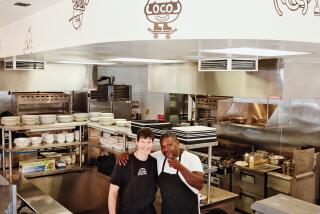Market Focus : The Small Loco Is Very Big Business in Santiago : The mollusk is similar to abalone and just as scarce. Chileans now hope to ‘farm’ California red abalone.
- Share via
SANTIAGO, Chile — Domingo Manriquez had only a couple of dozen locos left for sale at his seafood stall in Santiago’s colorful Central Market on a recent Friday morning. The price was the equivalent of $3.65 for each mossy shell containing a fleshy gray morsel not much bigger than a hockey puck.
“People complain that it is expensive for a national product, but they buy anyway,” Manriquez said. “They want to eat locos.”
Years ago, locos--a mollusk similar to abalone found mainly in Chilean waters--were popular and cheap, a tasty seafood staple that abounded up and down the long Chilean coast. But since Asian countries such as Taiwan and Japan began importing them in large quantities as a substitute for scarce abalone, locos have also became scarce and expensive.
Now, in response to the depletion of loco stocks, Chileans are preparing to “farm” California red abalone for the international market. The joint venture between a California-based company and an innovative nonprofit group is part of Chile’s plunge into aquaculture, or sea farming, a lucrative industry in which this country already has made remarkable progress.
Someday, perhaps, abalone farms will relieve pressure on Chile’s depleted loco stocks. But that pressure was at a peak for two weeks in late July and early August, when authorities temporarily lifted a protective ban on capturing the prized mollusks. Ten thousand licensed divers plunged into the cold Pacific waters in a harvest frenzy that left at least one man dead from the bends after surfacing too fast, and seven drowned and eight were missing after their overloaded boat capsized.
*
Most of the estimated 17 million locos brought in during the brief season are being exported, leaving Chileans with their mouths watering. Many loco lovers blame their privation on the Asians.
“They don’t leave anything for the domestic market,” said Manriquez, 47, an avid seafood eater who likes his locos boiled and served with potatoes and mayonnaise.
Although the loco and abalone are both univalve mollusks, their biological kinship is distant. The abalone belongs to the genus Haliotis and is herbivorous, feeding on algae and other plant life. The loco’s genus is Concholepas, and it eats crabs and other small sea animals.
The abalone’s edible “foot” is usually more tender than the loco’s and is bigger around but not as thick. The abalone also has a stronger flavor, though some gourmets prefer the more delicate-tasting loco.
Members of the abalone family, also known as ear shells or sea ears, are found in Asia, Australia, New Zealand, South Africa, California and Mexico.
For many Chinese and Japanese, abalone is a delicacy, relished in family meals on special occasions. And of course in California, the breaded and fried abalone steak is also a traditional treat.
Overharvesting and pollution greatly reduced natural world stocks of abalone in past decades. After Asians discovered the loco as a substitute, Chile’s loco stocks also declined sharply. In 1988, the Chilean government imposed a protective ban on capturing the animals but opened a 15-day season with a 5,000-ton limit on the total take. In a wild free-for-all, divers captured 16,000 tons. Prices plummeted, and protests by fishermen turned violent.
*
Since then, enforcement of the ban has been far from perfect. Because of the mollusk’s high price, poaching and smuggling has become a multimillion-dollar industry. A “mafia” buys locos illegally from fishermen and exports them to Asian importers in cans labeled as mackerel or sardines--sometimes smoothing the way with bribes.
“It is in the mafia’s interest that there be a ban because they buy at a very cheap price, process them in clandestine plants and sell them for big money,” said Manuel Achurra, an economist and editor of the fishery trade magazine Chile Pesquero.
Authorities have confiscated hundreds of thousands of illegally harvested locos since the ban began, but the clandestine industry is still estimated to bring in more than $50 million a year.
When the ban was briefly lifted in January and again in July, the going price for locos made them prohibitively expensive for most Chileans, but there was no lack of demand in Asia.
Achurra predicted that the Asian market for loco and abalone will continue to grow as China’s market reforms enable more people to buy such imports. “The answer will have to be cultivation,” he said.
Loco farming--never successfully done on a commercial scale--would probably prove prohibitively difficult because of the carnivorous animal’s dependence on a complex food chain. But the herbivorous abalone already is being cultivated successfully in Asia and California.
A California producer, Ab Lab Aquaculture Industries of Port Hueneme, is participating in Chile’s first abalone farming project. Ab Lab’s Chilean partner is Fundacion Chile, or the Chile Foundation, a nonprofit corporation that invests in private development projects aimed at expanding Chile’s economy with new technology.
The foundation and Ab Lab are working together in a $1.5-million joint venture called Semillas Marinas S.A., or Marine Seeds Inc. In June, Semillas Marinas began producing red abalone “seeds,” or baby shellfish, in nursery tanks at the coastal town of Las Cruces, 85 miles from Santiago.
Fundacion Chile and Ab Lab are starting a separate, $2-million “grow-out” company that will raise baby abalone to a marketable size of four inches in diameter. Marine Seeds will also encourage other seed producers and grow-out companies to enter the market, selling them technology and baby abalone.
Carlos Wurmann, Fundacion Chile’s marine resources manager, said coastal property values and other costs are much lower in Chile than in California, while requirements for environmental impact studies are less cumbersome. “Consequently, it makes sense to produce abalone in Chile,” he said.
A four-inch abalone, which will take about three years to produce in Chile, currently wholesales for $3 to $4 live in Tokyo, Wurmann said. That’s $13 to $18 a pound. He said his foundation plans to air-freight live abalone to Asia and to Asian communities in California and Brazil. If international economic conditions favor growth in consumption, Wurmann calculated, Chile could be exporting 500 to 1,000 metric tons of abalone a year by the end of the decade. That is no pipe dream, judging by Chile’s record with salmon.
*
Fundacion Chile pioneered salmon farming on the southern coast in the early 1980s. By 1992, Chile was the No. 2 salmon-farming country in the world after Norway, with annual revenue of $270 million from exports of 50,000 metric tons. Chile also has begun cultivating sea scallops and turbot for export.
Fundacion Chile is investing in turbot farming in northern Chile, importing the technology from Mannin Sea Farms on the Isle of Man. The foundation started a pilot project with a hatchery and a grow-out farm near the town of Tongoy in 1989.
Early this year, the grow-out began producing small quantities of 4-pound turbot, which have been successfully exported to Los Angeles and New York. Fundacion Chile and private investors started operating a commercial turbot hatchery named Tecnofish S.A. in March, and they are preparing to launch a major grow-out called Seafood Resources Chile.
Chilean turbot production is scheduled to increase from 80,000 pounds this year to 300,000 pounds in 1995, said Fundacion Chile’s Wurmann. By the turn of the century, he predicted, production will reach more than 2 million pounds.
But Fundacion Chile will never be satisfied, it seems. It’s next sea-farming project is to raise sturgeon, a fish whose eggs are used to make caviar. The sturgeon used on the project will come from Northern California, Wurmann said.
“Everything is ready,” he said. “The first sturgeons are in Chile.”
More to Read
Sign up for Essential California
The most important California stories and recommendations in your inbox every morning.
You may occasionally receive promotional content from the Los Angeles Times.










